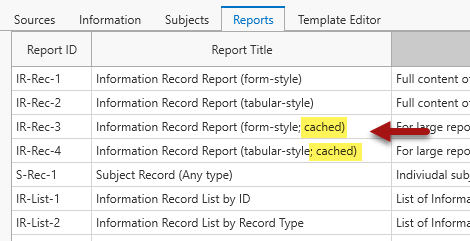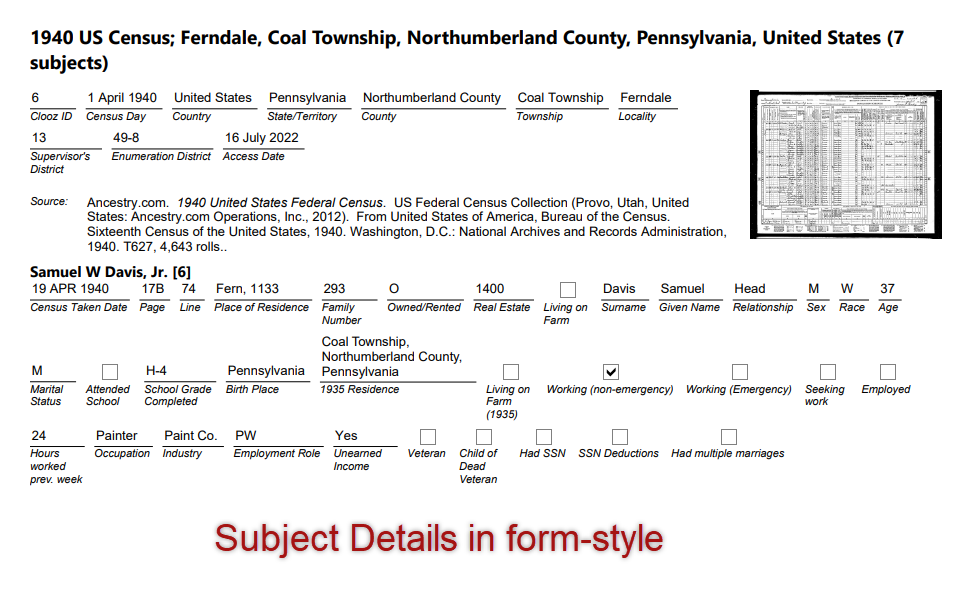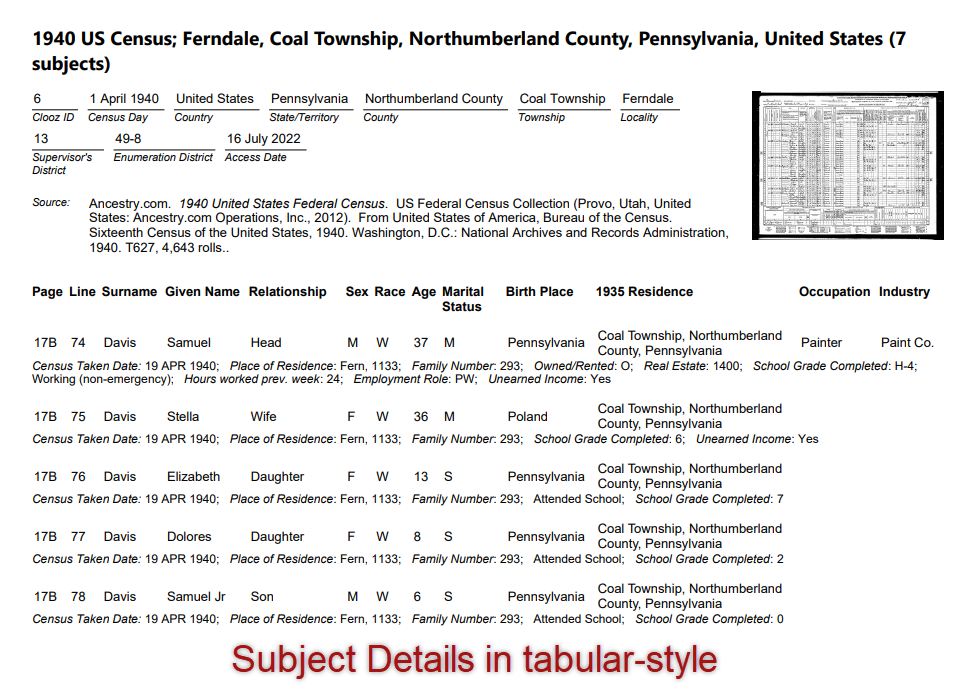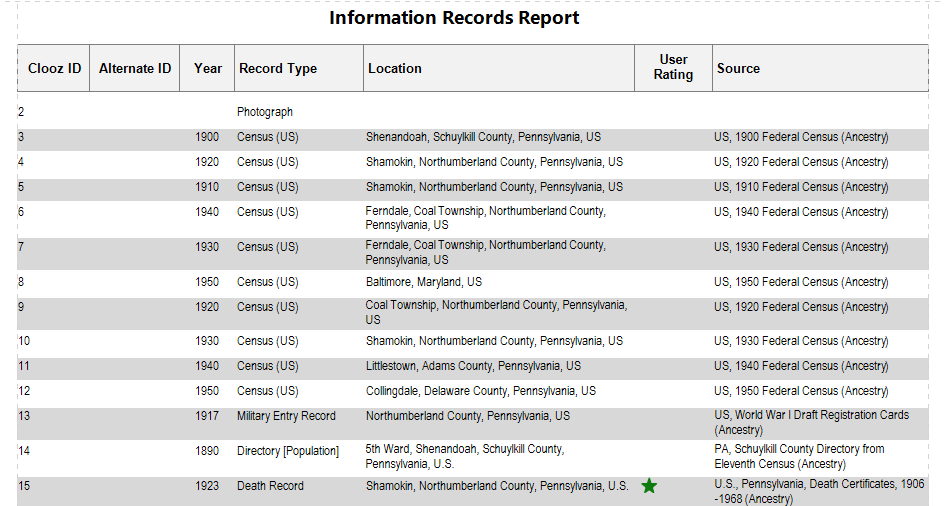Report Layout Types
There are two types of layouts used in Clooz's reports to organize how the records appear in the report and how much of the details are included. These are:
-
Individual Record Reports, and
-
List Reports.
Individual Record Reports
Reports using the individual record type layout can include all of the data associated with each record (equivalent to that available when editing a record in the record editor). Information Records![]() Information Records in Clooz hold the content information coming from a document or other source. These differ from a Source record that contains most of the citation information describing the docment, or the Repository record referring to the facility or online service where the document was found., for example, would include associated events and families, related research tasks
Information Records in Clooz hold the content information coming from a document or other source. These differ from a Source record that contains most of the citation information describing the docment, or the Repository record referring to the facility or online service where the document was found., for example, would include associated events and families, related research tasks![]() A search or analysis action to be conducted while attempting to fulfill a Research Objective., linked media items, a source
A search or analysis action to be conducted while attempting to fulfill a Research Objective., linked media items, a source![]() A source record in Clooz should be viewed as the higher level components of a source citation. Citation details are pulled from the citing Information Record. and repository
A source record in Clooz should be viewed as the higher level components of a source citation. Citation details are pulled from the citing Information Record. and repository![]() Where a source document or item was found. This could be a physical library facility or online data provider..
Where a source document or item was found. This could be a physical library facility or online data provider..
Individual Record Layout for Information Records
Information Records have an additional level of detail (the details for each subject![]() Subjects are the objects you are gathering information about. In most cases with Clooz, this is people. However, Clooz supports several other types of subjects such as businesses, real estate/buildings, ships and artifacts.) when compared to other record types. This data can be formatted in a form type style, or in a table/tabular style. This only applies to the subject detail fields. This is somewhat parallel to the difference in form and tabular templates for the Information Record editor, although either style can be used with any type of Information Record (whether it was a form template or a tabular template).
Subjects are the objects you are gathering information about. In most cases with Clooz, this is people. However, Clooz supports several other types of subjects such as businesses, real estate/buildings, ships and artifacts.) when compared to other record types. This data can be formatted in a form type style, or in a table/tabular style. This only applies to the subject detail fields. This is somewhat parallel to the difference in form and tabular templates for the Information Record editor, although either style can be used with any type of Information Record (whether it was a form template or a tabular template).
Data fields, when presented using the form style, show each data field with the field label appearing beneath the value. The whole block of fields gets repeated for each subject in the Information Record. The block of data for one subject is not split across page boundaries.
Tabular style details are listed in rows and columns, with the column header appearing at the top. Note that with the tabular style, whatever fields cannot fit within the width of the page are consolidated on the lines following. Those fields having the most interest in family history research have been given a higher priority to appear in the initial row of data. Therefore, the order of the fields may not be exactly the same as the original editing template.
Tabular style uses less space than the form style. However, the form style is more compatible to changes of the page orientation to Portrait mode.
The example reports shown above include a thumbnail image of the document. The size of this thumbnail is an option given in the Report Viewer (including eliminating it). The are other options such as skipping blank fields or consolidating location parts (country, state, etc) into a single location sequence to save space.
In Clooz 4, some record types such as Information Records can have a large amount of data (associated events, families, media links, etc.). Therefore, even a single individual record can result in a multi-page report. Since reports using this layout can actually include multiple records (such as multiple Information Records or multiple Subjects), you should be careful regarding how many records you seek to include in this type report. Besides taking a long time to process, the report could quickly grow to hundreds or thousands of pages.
 Reports are assembled in your computer's memory, so it is possible the size of the report you generate exceeds the amount of free memory in your system, resulting in an Out of Memory error. You could reduce the size of thumbnails or eliminate some of the detailed sub-item categories to reduce the size of the report. However, there are some special reports designed to cache the report contents to your computer's disk instead of holding it all in memory, allowing you to produce very large reports. These report types are tagged as "cached". They require less memory, but take longer to generate. If you are generating a report using the Individual Record Layout for many Information Records, you may need to use the cached version of the report depending on your computer's resources.
Reports are assembled in your computer's memory, so it is possible the size of the report you generate exceeds the amount of free memory in your system, resulting in an Out of Memory error. You could reduce the size of thumbnails or eliminate some of the detailed sub-item categories to reduce the size of the report. However, there are some special reports designed to cache the report contents to your computer's disk instead of holding it all in memory, allowing you to produce very large reports. These report types are tagged as "cached". They require less memory, but take longer to generate. If you are generating a report using the Individual Record Layout for many Information Records, you may need to use the cached version of the report depending on your computer's resources.
 Reports generated using this cached approach are generated in background, allowing you to begin viewing the beginning pages of the report while the rest is completed. The status (number of pages generated) is shown in the lower left corner of the report viewer window.
Reports generated using this cached approach are generated in background, allowing you to begin viewing the beginning pages of the report while the rest is completed. The status (number of pages generated) is shown in the lower left corner of the report viewer window.
List Reports
List type reports only provide a limited set of information for each included record. This is the same set of information that is used in the lists of records that appear on the main screen of Clooz.


